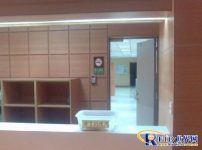
Project case of access control card control system in Xiamen Chang Gung Memorial Hospital
[ad_1]
The basic principle of hospital access control is to isolate the public free activity area and the controlled special activity area, and use the IC card instead of the key to open the door. Install access controllers at the corresponding entrances and exits, set access control points in the security center, and set access permissions for each cardholder. Those with access rights can use their personal cards to prevent illegal entry and ensure the order and safety of the hospital.
This plan mainly explains the use of TCP/IP access control system to achieve the intelligent management of the hospital, and provides the most convenient and fast working and living space for employees and past personnel on the premise of providing safety to the hospital. At the same time, it also creates a safe, convenient, fast, orderly and comfortable medical environment to provide the society with high-quality and high-level services for diagnosis and treatment, work, study and life, improve the information level of hospital medical management, and enhance the hospital’s market competitiveness . It also fully embodies the concept of “humanization, informationization, and health park”, and it is also an important manifestation of the realization of a digital hospital management card.
The application of “Access Control Card” covers hospital outpatient areas, emergency centers, infectious disease areas, apartment dormitories, physical examination centers, inpatient buildings, administrative buildings, scientific research and teaching buildings, advanced wards, health centers, etc.
Among them, the key points include the first basement of the medical and technical administration building, and five above ground, with a total floor area of approximately 80,656 square meters;
The ward building has one basement floor and 19 floors above ground, with a total floor area of approximately 114,806 square meters;
The basement of the civil air defense basement has a floor area of approximately 13,778 square meters;
The power center has one basement level and two floors above the ground. The floor area is about 8,255 square meters. ;
The medical dormitory has six floors above ground, with a floor area of approximately 9,186 square meters;
The user card adopts the MF1 IC S50 MIFARE ONE non-contact IC card (referred to as “IC card”) of PHILIPS Company; the card reader adopts ER-981C, ER-D200T access control based on TCP/IP protocol produced by Yishili Company More than 200 sets of systems;
Data communication uses the network platform provided by the hospital’s integrated wiring system. The card reader machine adopts the TCP/IP protocol to directly connect to the local area network without using a communication conversion device, and a dedicated RS-485 bus is laid on a special part and the card reader machine tool based on the RS-485 bus is used;
The database server shares the dual cluster server of the hospital data center;
Card management function: provide card making and issuing services. The first issue of medical staff work cards (including family members and foreign workers), patient visit cards, and temporary access cards;
System maintenance function: provide hardware, software, network, database maintenance services;
Operation management function: provide data setting, query, statistics, and report services through the computer;
Access control management function: adopts Ethernet communication technology, data is automatically uploaded in real time, and the controllers communicate with each other. When entering and leaving the controlled area of the hospital, the door is automatically opened by swiping the card.
There are multiple ways to open the door: card, password, card+password, card or password, multi-card and multi-card+password, etc., which can flexibly set a variety of door states, such as: safe, normally open (support the first card to open the door), sleep , Password, APB, etc., and integrate three major security functions such as access control, anti-theft alarm, and video surveillance;
The overall system design embodies the principles of economy, advancement, openness, integration on demand, and scalability.

Newborn baby ward
[ad_2]



